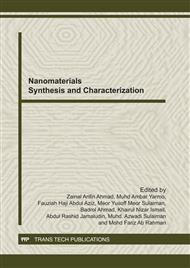p.202
p.206
p.211
p.217
p.222
p.228
p.232
p.238
p.243
Novel Method: Coral Like Structure of Align Carbon Nanotubes (A-CNTs) on Porous Silicon Template (PSiT) without Catalyst; Green Approach
Abstract:
Align Carbon Nanotubes (A-CNTs) is very promising materials and offer attractive applications especially in opto-emission devices and nanoelectronic. Normally CNTs prepared by catalytic chemical vapor deposition using various types of template such as alumina, quartz, silicon and glass template. In this paper, Novel method was introduced to prepare A-CNTs which is combination between immersion and evaporation method. The align CNTs were successfully growth on Porous Silicon template (PSiT) without catalyst. Camphor oil is used as precursor and evaporation temperature is at 800 °C. The PSiT was prepared by photo-electrochemical anodization method. The surface morphology of PSiT layer and A-CNTs were studied using Field Emission Scanning Electron Microscope (FESEM).While Raman spectroscopy will be carried out to study the degree of crystallinity or graphitization of A-CNTs. The growth mechanism will be discussed in this paper. Stubby A-CNTs was successfully growth with 30 nm diameter and 250 nm length on PSiT without metal catalytic process. Meanwhile, this novel technique was found that PSiT is an ideal template for growing A-CNTs without metal catalyst assisted. This novel technique was capable to obtained carbon nanotubes without metal catalyst assisted and improves their purity of product with low cost.
Info:
Periodical:
Pages:
222-227
Citation:
Online since:
October 2011
Price:
Сopyright:
© 2012 Trans Tech Publications Ltd. All Rights Reserved
Share:
Citation:


